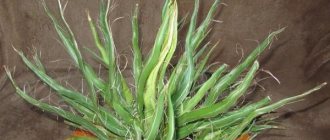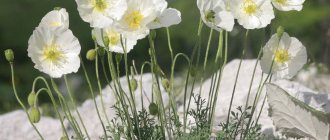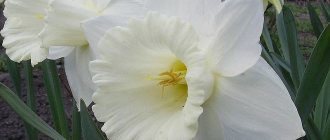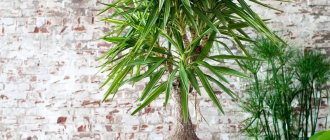Opuntia is the largest genus belonging to the Cactus family. This genus includes approximately 190 species. Under natural conditions, prickly pear can be found in South and North America, not excluding the West Indies. Approximately half of all species are found in Mexico.
There is an Aztec legend that says that the main Aztec city of Tenochtitlan was founded on the very spot where an eagle ate a snake while sitting on a prickly pear. On the coat of arms of Mexico you can see exactly this scene. Some prickly pear species had stems and fruits that were used as food by the Indians. In addition, this cactus was cultivated to obtain a coloring substance such as carmine. However, there are species that are very aggressive neophytes; in order to destroy such prickly pear, biological preparations are used. At home, prickly pear is grown in all countries, even in Australia.
Brief description of cultivation
- Bloom . In indoor culture, prickly pear blooms very rarely.
- Illumination . In the morning, the bush needs a lot of bright light from the sun, but in the afternoon it should be diffused.
- Temperature regime . In the spring-summer period, normal room temperature is suitable for the plant; in winter, the room should not be warmer than 5-7 degrees.
- Watering . In the warm season, the substrate is moistened moderately, and in the winter months, if the bush is at rest, it is not watered at all. Water the bush using the bottom method (through a tray).
- Air humidity . Feels normal in any humidity.
- Fertilizer . The plant is fed once every 30 days in March–September; a mineral complex with a low nitrogen content is suitable for this. From October until the beginning of spring there is no need to feed the cactus.
- Rest period . With the onset of autumn, watering is reduced, the application of fertilizers to the substrate is stopped, and the bush itself is removed to a rather cold place (from 5 to 7 degrees), where it will remain until March.
- Transplant . While the bush is young, it is replanted every year, while older specimens are subjected to this procedure once every 3 or 4 years (not more often). Transplantation is carried out in the spring before the growing season begins.
- Reproduction . In segments, and also rarely use the seed method.
- Pests . Mealybugs, scale insects, spider mites, root-knot nematodes and whiteflies.
- Diseases . Late blight, wet stinking rot, pythium root rot and gray mold.
Amazing prickly pear is blooming!!! Delicious cactus!!! How to grow at home?
Eating
Prickly pear is used as a culinary ingredient in southern countries. In Mexico and Central America, for example, the national fava bean has been cooked for several decades. It is used in salads, used as a vegetable, eaten as a fruit, and a healthy, aromatic tea is made from its flowers.
In Spain, during the annual farmers' festival, you can try various dishes made from this cactus.
In some countries, after harvesting, cactus is used to make juice, sauces, pickle, bake or fry. It can also be used to make all kinds of desserts, sweetened or boiled in syrup. Opuntia fruits taste like juicy strawberries, raspberries or pears. You can make the most wonderful jams, creams, soufflés, canned food and other delicious dishes from cactus.
Features of prickly pear
The prickly pear cactus is an evergreen perennial. This genus is represented by creeping or erect shrubs, as well as trees with articulated, succulent, flat-shaped shoots. On their surface there are small and large spines, as well as delicate thin hook-shaped bristles collected in bunches, which are called glochidia. The succulent small leaf blades have an awl-shaped shape. Bisexual flowers grow solitary and can be orange, yellow or deep red. The fruit is a berry covered with a dense shell containing seeds. The fruits are edible.
Caring for prickly pear at home
Lighting
Prickly pear is a light-loving plant, and for normal growth and development it requires a large amount of bright light every day at any time of the year. If the cactus was in the shade, then it needs to be gradually accustomed to direct sunlight.
Temperature
At normal room temperature, the flower grows and develops normally throughout almost the entire year. But in winter it is recommended to move it to a cooler place (from 5 to 7 degrees). If the prickly pear is in a warm place in winter, this will lead to its painful, strong stretching.
Watering prickly pear
In spring and summer, the substrate in the pot should be moistened moderately. The fact is that prickly pear, like other succulent plants, reacts poorly to excess moisture. In winter, if the bush is dormant and at the same time standing in a cool place, then watering should be stopped completely until spring.
Moisten the soil mixture only after it has completely dried. Water the prickly pear using the bottom watering method. First, prepare soft water: let it sit for at least 24 hours, after which it is mixed with citric acid (several grains of acid per 1 liter of water). Pour water into a deep container and lower the pot of prickly pear into it.
During normal watering, when water is poured under the root, droplets of moisture can fall on the stem of the flower. This leads to blockage of the pores and disruption of tissue respiration, as a result of which cork growths form on the surface of the stem.
Air humidity
The plant is undemanding to air humidity. It can grow and develop normally even in a room with very dry air. In this regard, the bush does not need additional moisture either on hot days in summer or in winter, when the air in the room is dried out by operating heating devices.
Fertilizer
Prickly pear should be systematically fed only during the growing season (March–September). To do this, use a mineral complex with a reduced nitrogen content, which should be added to the substrate no more than once every 30 days.
Replanting prickly pear
This succulent does not tolerate transplantation well. That is why adult bushes are replanted quite rarely, approximately once every three or four years. This is done in the spring before the growing season begins. If there are buds on the bush, then the transplant will have to be postponed until next year. Young cacti that are not yet three years old are replanted regularly once a year.
Since the root system of such a plant is very weak, you should choose a wide and low pot for planting it. A suitable soil mixture should consist of clay, sand, turf and leaf soil (2:1:2:4). It is also recommended to add a small amount of crushed charcoal, expanded clay or small pieces of brick to the substrate. Please note that humus cannot be added to the soil mixture. If you wish, you can simply purchase ready-made soil mixture for cacti in a specialized store.
Transplantation of prickly pear is carried out using the transshipment method, while trying to keep the earthen lump intact. The transplanted bush cannot be watered during the first 7 days.
70. Opuntia cactus. Transplanting into a new pot
Prickly pear: a cactus for growing in open ground in temperate latitudes
Admiring cacti in flower beds outdoors is a privilege not only for residents of hot countries.
There is a frost-resistant species of prickly pear (Opuntia), which is adapted to growing in temperate climates. This plant will appeal to those who are ready to add some creativity to the landscape and strive to modernize the garden design.
Where to plant prickly pear
The cactus grows in one place for a long time, until the desire arises to change the filling of the flower garden. It does not need to be replanted, you just need to maintain the soil in a condition favorable for the development of the plant.
Considering this, it is recommended to immediately find the right permanent place for the prickly pear so that it feels comfortable.
A native of hot countries prefers to grow in sunny areas, protected from the wind by tall trees or the walls of houses.
Prickly pear grows well surrounded by stones, so it can be planted in a rock garden or on an alpine hill. In addition to the fact that the plant will like stone placers, they will perfectly complement the garden landscape.
Prickly pear blossom
Caring for prickly pear during flowering
Indoor prickly pear rarely pleases with its flowers. Experts still cannot find an answer to the question of why this happens. According to one version, the lack of flowering is due to the fact that this cactus is slow-growing, and according to another, because indoors it is impossible to recreate the conditions to which prickly pear is accustomed in nature.
But still, sometimes buds form on the bush. And here it is important to avoid mistakes in care, due to which they can fly around:
- you cannot move the pot with the plant to another place or even turn it;
- transplantation is prohibited;
- care for the cactus in the same way as you took care of it before: water and fertilize in accordance with the established rules.
Violation of even one of the listed points can lead to the buds falling off or their degeneration into vegetative shoots.
Care after flowering
At the end of flowering, a gradual reduction in watering should be carried out. They also stop feeding the bush, after which it is moved to a cold room (from 5 to 7 degrees), where it will remain until the onset of spring. At this time, the cactus is not fed or watered.
Review of the prickly pear cactus, varieties of different flowering periods.
Benefits of cactus berries
The beneficial properties of the queen of cacti have long been beyond doubt. This wonder is recommended for obese people - the plant extract is included in weight loss medications. Berries have a beneficial effect on the stomach and intestines. They promote the production of insulin, which is why they are recommended for people with diabetes.
The pulp of the fruit tones and quenches thirst. The decoction can even lower high temperatures.
If you wish, you can make jam, jam, liqueurs, marmalades, candied fruits and all kinds of sauces from the fruits and stems of prickly pear. Plant stems no more than 1 cm thick are suitable for food. You can also add them to salads.
The stems, unlike the fruits, are considered vegetables. They can be baked, stewed and boiled - this is an option to surprise your guests! How to store these berries? If frozen, some of the beneficial substances will disappear, but if dried, there will be more benefits.
Reproduction methods
Cuttings
Prickly pear growing at home is easiest and fastest to propagate by cuttings. To do this, you will need to separate several segments from an adult bush. They are left for 3-4 days in an upright position to dry. During this time, a strong film should appear at the cut site.
For rooting, the cuttings are planted in moistened and pre-disinfected sand, and they need to be buried 30 mm into the substrate. The top of the cuttings is covered with a transparent cap (a glass jar, a cut plastic bottle, etc.). Provide systematic ventilation to the cuttings, and also moisten the sand if necessary. The optimal temperature for rooting is about 20 degrees, and you will need bottom heating. When the cuttings take root, they are planted in individual small pots, using the same soil mixture as for transplantation.
How to root an unpretentious fast-growing prickly pear cactus (Opuntia)? Propagation by cuttings
Growing from seeds
Each prickly pear seed is covered with a very dense, durable shell. Therefore, in order to increase their germination, it will be necessary to carry out scarification: for this, using a file or sandpaper, it is necessary to “treat” the surface of the seeds. Thanks to scarification, it will be much easier for the sprout to pass through the thick shell.
Prepared seed material for 10 minutes. immersed in a light pink potassium manganese solution. After this, it is sown in a pre-sterilized soil mixture, which includes river sand, crushed charcoal and leaf soil (2:1:2). A drainage layer of expanded clay must be made at the bottom of the container.
The crops are covered with glass or film on top, then they are placed in a warm place (about 20 degrees) and provided with systematic ventilation. Do not forget to moisten the soil mixture immediately after its surface dries.
Grown seedlings should be planted in individual small pots, after which they are grown over the course of a couple of years. Choose a bright place for young cacti, protected from direct sunlight. Grown bushes are planted in a soil mixture for adult prickly pears (see the “Transplanting” section).
Cacti from Opuntia seeds
Application in medicine
Let us present to your attention several recipes that will help fight the following diseases:
Compress for rheumatism. If you want to make a compress to treat radiculitis, it is best to take middle-aged prickly pear for raw materials. Cut off two leaves located at the top of the plant. Plant them in a pot. The lower ones will be used in the form of medicine
Next, you need to carefully remove all the thorns, both large and small, with a knife. Next, cut a 1 cm wide strip from the leaf.
We put the rest in the refrigerator. Grind the cut part to a paste. After this treatment, all that remains is to rub it into the damaged area.
Rub in for 1-2 minutes, then cover with paper, preferably parchment paper. And put as much cotton wool as possible on top of the paper. A plastic bag is placed on the cotton wool, after which we tie a wool scarf around this area. It is best to do this compress before bed. If rheumatism has just begun to manifest itself, then 1-3 procedures will be enough. If you suffer from such a disease for a long time, then the course of treatment should be within 10 procedures. In the morning, when removing the compress, do not wash off the remaining consistency. It will be better if you scrape it off with your fingernails. You will not notice such consequences as burns, discomfort, or relapses.
Tincture against aching legs. To prepare the tincture, you will need a leaf of the plant, which must be cut into pieces and poured with vodka in a dark-colored container. You need to insist on it for about two weeks. Take prickly pear tincture 15-18 drops orally. It can also be applied to sore feet. The feeling of lightness will not take long to arrive.
A product with a healing effect. We clean the cactus from thorns and skin. Apply a peeled piece of prickly pear to a wound or ulcer. We bandage it. We repeat this procedure 5-6 times.
A drug according to a Chinese recipe. The Chinese used prickly pear to make a medicinal drink. To do this, they took 100 grams of peeled cactus (from needles and skin) and added honey and egg white to it, after which they consumed it internally.
Diseases and pests of prickly pear
Pests
Mealybugs, scale insects, spider mites, nematodes and whiteflies can settle on indoor prickly pear. Adult whiteflies do not harm the plant; their larvae are dangerous. All these pests are sucking, that is, they feed on plant sap, which they suck out through small punctures.
To get rid of pests, the plant is treated with a solution of an acaricidal drug, for example: Bankol, Actellik, Decis, etc. Before you start spraying the bush, you should protect the surface of the soil mixture from droplets of the pesticide. The bush is sprayed again after 1–1.5 weeks.
It is very difficult to understand that a plant is affected by root nematodes. They can only be detected during transplantation: carefully examine the roots; on their surface you can see swellings that form as a result of the vital activity of nematodes. Take a very sharp knife and cut out the affected areas, grabbing some healthy tissue. Then the root system is kept in very warm (45 to 50 degrees) water for 10 minutes. Do not wet the root collar under any circumstances! Remove the roots from the water and wait until they dry. Then sprinkle the cut areas with crushed charcoal. Plant the flower in a new disinfected soil mixture.
Diseases
This succulent plant is susceptible to diseases such as late blight, wet stinking rot, pythium root rot and gray mold. All of these diseases are fungal. Pathogenic fungi can be present in the substrate, and their activation is observed under favorable conditions: systematic stagnation of moisture in the substrate or oversaturation of the soil mixture with nitrogen.
All diseased parts of the affected bush must be cut out, after which it is treated with a solution of a fungicidal drug, for example: Gamaira, copper sulfate, Bordeaux mixture, Oxychome, etc. When working with pesticides, do not forget to follow safety precautions.
Prickly pear cactus / How to care for cacti? / How to plant prickly pear?
How to replant succulents
How to properly replant succulents? This must be done gradually and slowly.
On this topic:
Stage No. 1. Preparatory
At the preparation stage, which begins a few days before replanting, the plant is no longer watered. This is necessary so that the roots can be easily removed: the dry soil mixture will simply fall off from them. Also, no additional manipulations are carried out with the succulent.
During this time prepare:
- a new container for the flower (usually choose a little larger than the previous one so that the roots have enough freedom in it);
- soil mixture;
- drainage.
Stage No. 2. Extracting the plant
Removing a plant from a flower pot should be done carefully, without using force. In the case of a purchased sample, when the succulent was grown in peat, the roots must be carefully cleaned from the substrate and dried for a couple of days.
If the root system is tightly entwined with an earthen ball, you will have to use a thin wooden stick to free the roots. Removing old soil will help the succulent grow and develop better after replanting. If there are damaged or dried roots, it is better to trim them.
How to replant a succulent in cases where it is difficult to remove it from the pot? It is permissible to turn the container over and knock on it a little. In difficult cases, when the root system cannot be easily removed, you can even destroy the pot itself.
On this topic:
BACK
FORWARD
1 of 2
In situations where quite a lot of roots were damaged when removing the plant, planting should be postponed. The succulent itself is placed in a warm, dark place for a couple of days to allow the damage to dry out.
Stage No. 3. Landing
Planting must be done as follows:
- Drainage (expanded clay, broken brick) is poured into the prepared container.
- A little prepared soil mixture is poured on top.
- The plant itself is planted. The roots are straightened.
- The free space is covered with earth. It should be sprinkled evenly over the entire area so as not to break the symmetry.
- The soil around the plant should be compacted a little (without too much effort) so that the succulent is fixed. At the same time, the plant should not be allowed to be too deep.
- Pebbles or expanded clay can be poured on top of the ground. This is optional, but highly desirable for succulents.
Work on mistakes
When the plant has already been planted, but the ground has not yet been watered, you can correct some planting errors.
| No. | Problem | Solutions Problems |
| 1. | After compacting the soil, it turned out that the plant was planted deep. | You can gently pull the plant up by shaking the pot or tapping it |
| 2. | Not all roots are covered with soil, and it is no longer possible to add more. | It is necessary to remove the plant and begin the planting process again. |
| 3. | The plant is planted asymmetrically. | By tapping the pot, you can try to correct the angle of the plant. This should be done without the use of force. If it doesn’t work out, you’ll have to repeat the landing. |
| 4. | They forgot to put drainage on the bottom. | The landing will have to be repeated |
Types of prickly pear with photos and names
There are quite a large number of species and varieties of prickly pear, and many of them are quite widespread in indoor cultivation. Below we will describe those that are most popular among gardeners.
White-haired prickly pear (Opuntia leucotricha)
This tree-like cactus has stems consisting of segments, each of which reaches a length of 10 to 20 centimeters. Their surface has dense bristles, as well as many yellow glochidia. During flowering, flowers are formed on the bush, reaching about 80 mm in diameter. They are painted in a golden hue, while their stigmas are green. Edible fruits have a pleasant smell.
Berger's prickly pear (Opuntia bergeriana)
This perennial plant has a stem consisting of segments of a rich pale green color, which reach a length of 20 to 25 centimeters. The stems have a small number of areoles, which contain spines of various sizes, brownish-yellow or yellow in color. During flowering, many yellowish-orange flowers with green stigmas appear. They cover the bush abundantly.
Opuntia main (Opuntia basilaris), or main prickly pear
This species is represented by a bush-like cactus, the stems of which are very long and branching. They consist of pale red or greenish-blue segments, the length of which is 8–20 centimeters. The depressed light brown areoles have pubescence and also some needles. Flowers can be painted in various shades: from deep red to pink. This plant has varieties: nana and cordata.
Gosselin's prickly pear (Opuntia gosseliniana)
Over time, such a bush-like cactus develops a not very large clump, which consists of thin segments. In young bushes these segments are painted pale red, and in adults they are greenish-gray. Soft needles, as a rule, grow from areoles located in the upper part of the bush. The color of the flowers is yellow. There is a variety of santa rita: on the edges of the rounded segments there is a blue tint, while there is a dark purple pattern around the areolas.
Long-awned prickly pear (Opuntia longispina), or long-thorned prickly pear
This is a creeping, bushy perennial plant. Its stems consist of small spherical-club-shaped segments of a slightly flattened shape, their length is from 30 to 40 mm, and they are collected in chains.
This plant has brown areoles and red glochidia, as well as the marginal needles. There is also a thin, long central spine. Red or orange flowers are wide open.
Opuntia curassavica
The shoots of this perennial bush-like plant are drooping, they consist of greenish narrow segments that easily break off, their length is 20–50 mm. The short-haired small areoles have light-colored needles.
Opuntia fragilis
This bushy plant's shoots include easily falling segments, the length of which is from 20 to 30 mm, they are almost flat or round. The small areolas are located at a distance of 0.8 to 1.2 cm from each other. They have white pubescence, the glochidia are light yellow, and there are also 4 brownish-yellow needles about 30 mm long, which are placed crosswise. Yellowish flowers have green stigmas.
Opuntia microdasys
The length of the branched stem is about 0.5 m. It consists of small round segments of a dark green hue. Each white areole contains a large number of golden glochidia. The inner part of the flowers is yellow-golden, while the style is whitish in color.
Indian prickly pear (Opuntia ficus-indica), or Indian ficus
The stems of such a bush-like cactus are erect and become woody over time; in the upper part they are highly branched. The shoots include greenish-gray oval-shaped segments, on which there are a small number of areoles, decorated with easily falling glochidia of light yellow color, as well as white single needles. The color of the flowers is deep red. The pear-shaped fruits can be eaten; they are colored green, pale red or yellow. Their flesh is translucent white with a pleasant sweetish taste, and they also have large seeds.
Opuntia scheerii
This cactus is distinguished by strong branching. The bluish-green segments reach 15–30 centimeters in length. The stems are decorated with a large number of densely spaced areoles; they include brown glochidia, short needle-shaped (about 10 mm) spines, and corymbose hairs. The flowers are yellowish and their pistil is green. As they wither, they change their color to salmon pink.
Opuntia compressa
Creeping stems consist of rich green round segments. The plant may not have needles at all, or they may be located at the top of the stems. There are rounded pointed leaf blades and yellowish flowers.
Prickly pear: planting (update)
Description of cacti of the genus Opuntia
The succulent plant Opuntia is a large genus of 180 species of cacti in the family Cactaceae (Cactaceae) native to the Americas. Prickly pear is found from the Peace River in western Canada almost to the tip of South America. In the Northern Hemisphere, the Opuntia fragilis variety is one of the northernmost cacti species. In the West it is also called Paddle or Nopal cactus.
Most Opuntia species are erect or spreading cacti, ranging from small, low-growing shrubs to tree-like specimens reaching 5 meters in height. Prickly pear grows in arid and semi-arid areas and can be found on sandy coastal beaches, sandy prairies, and rocky hillsides. Although they love sun and thrive in hot climates, Prickly Pear is one of the more cold-hardy species of lowland cacti. Some varieties of prickly pear can withstand temperatures as low as -10 °C.
Opuntia are easily recognized by their flat, spade-shaped stem segments, called cladodes, growing one at the end of the other. The stem plates take root easily. The edges and flat surfaces of these cladodes are covered with areoles, which always have tiny, easily detachable spines called glochids.
Photo of glochids and spines of Opuntia
Many species of Opuntia have large needles in addition to glochids, but some are armed only with small needles. They appear soft, but anyone who touches them immediately regrets it. The small size of the glochids does not cause severe pain, but it does cause severe irritation.
Prickly Pear flowers open from spring to mid-summer, usually yellow, sometimes pink and rarely white or somewhere in between. The flowers are cup-shaped and do not have floral tubes, but the pericarps resemble rounded extensions of cladodes. It is not immediately possible to determine whether the new pagon will be a flower or a new cladode, as they are identical when first emerging—often covered with cone-shaped, deciduous leaves. Some prickly pears have very juicy, fleshy fruits that are harvested and made into candy or jellies. Likewise, the stem blades, when still young and tender, are harvested and eaten as vegetables - especially in Mexico under the name Nopales.
Several species of Opuntia, including the widely cultivated Opuntia ficus-indica from Mexico, are grown for their edible fruits and stems.
Many people despise Prickly Pear, even those who like to grow cacti. However, recently there seems to be renewed interest in this genus.
Properties of prickly pear
Useful properties of prickly pear
In a plant such as prickly pear, any part has healing properties. The foliage and fruits contain useful components such as: glucose, phosphorus, protein, calcium and magnesium; in shoots: protein, vitamin C, starch and sugar; in flowers: valuable amino acids. This cactus also contains large quantities of vitamins such as: B1, B2, B3, A and C. It also contains insoluble and soluble fiber.
Products made from prickly pear are used for:
- respiratory diseases;
- diabetes mellitus;
- diseases of the oral cavity and teeth;
- problems with the nervous system;
- diseases of the musculoskeletal system;
- diseases of the digestive system;
- metabolic disorders in the body;
- diseases of the cardiovascular system;
- hangover.
They are also used as a general tonic, to cleanse the body of toxic substances and toxins, and also for skin and hair care. This plant is used in the treatment of inflammation of the external integument, cystitis, diarrhea, measles, obesity, prostatitis, rheumatism, various wounds, etc. It is used to make glue, food coloring, oil, pectin, detergents and deodorants. Oil made from edible prickly pear contains a large amount of fatty acids, vitamin E and other valuable components that fight premature aging of the skin. This oil is included in expensive face creams; it is used in the care of the scalp and hair, as well as in aromatherapy.
Contraindications
A small number of people have an individual intolerance to prickly pear. Because of it, reddish spots form on the body, headache, vomiting and nausea appear during the first 30 minutes after taking the prickly pear-based remedy. If such symptoms appear, you should stop taking prickly pear.
The plant itself and products made from it should not be taken for acute cystitis and hemorrhoids. Since prickly pear is an exotic plant, before trying its fruits or preparations made from it, you should consult a qualified specialist.
OPUNTION CACTUS! EDIBLE FRUITS AND USEFUL PROPERTIES! HOW TO COLLECT!
Yucca: medicinal properties and contraindications, benefits and harms
Yucca is a tree-like evergreen plant with a straight tree-like, and in some species, tree-like branched stem, the diameter of which can reach up to 30 cm.
The leaves are large, hard, sword-shaped and can reach a length of more than a meter.
The fruits ripen in late September - early October and are a capsule or bulk berry with black seeds reaching 1 cm in diameter. Yucca has a rich and unique chemical composition. Its leaves contain:
- sapogenins: steroidal saponins, anthraquinones and aglycones;
- antioxidants;
- enzymes;
- enzymes;
- tigogenin;
- mucus.
The flowers contain:
- steroid sapogenins;
- Sahara;
- vitamins: A, C and group B;
- micro- and macroelements: selenium and zinc.
Concentrated in the roots:
- saponins;
- micro- and macroelements: Ca (calcium), Mg (magnesium), K (potassium), Zn (zinc), Fe (iron) and Cu (copper);
- vitamins: E, K and group B (folic and pantothenic acids, riboflavin, thiamine and niacin).
Beneficial features
The beneficial properties of yucca are provided by the unique nutrients in its composition:
- Steroidal saponins have antifungal properties. They also have anti-inflammatory and anti-allergenic effects, have an anti-edematous effect and lower cholesterol levels.
- Enzymes are actively involved in metabolism.
- Antioxidants – neutralize the effects of free radicals and harmful substances in the body, and also participate in the metabolic process.
- Mucus has an enveloping property, which is used in the treatment of gastritis, ulcers and other gastrointestinal diseases.
- Anthraquinones – have anti-inflammatory, astringent and laxative effects.
- Zinc - takes part in the synthesis of enzymes, proteins and fats, promotes the absorption of vitamin E by the body, normalizes the amount of sugar in the blood, keeps the skin clean, healthy, strengthens bone tissue and teeth.
- Selenium – exhibits antioxidant effects and promotes the absorption of vitamins E and C. Good for muscles and blood vessels. Increases the resistance of the immune system in the fight against viruses, and in combination with iodine ensures uninterrupted activity of the thyroid gland.
- Vitamin A - takes part in the synthesis of sex hormones and enzymes, and also helps restore vision and has a beneficial effect on the retina.
- Vitamin C is responsible for increasing immunity, takes part in the production of collagen and the synthesis of cartilage tissue, which has a beneficial effect on joints. Shows antioxidant properties.
- Saponins – stimulate the production of cortisone and have anti-inflammatory properties.
The beneficial properties of the plant are used for treatment:
- arthritis and arthrosis;
- prostatitis;
- diabetes mellitus;
- gastrointestinal diseases;
- skin diseases and rashes;
- nervous system;
- atherosclerosis.
Harm
Poisonous or not? Is it an allergen? Yucca is quite harmless and well suited for growing at home. But there are several points that owners of these plants need to know:
- Yucca is a low-toxic plant. If it enters the stomach in its pure form (when swallowed), indigestion, weakness, and tremors may occur. But there will be no serious consequences.
- Allergy to yucca. It is impossible to say for sure whether it is an allergen.
Often allergies are caused not by indoor flowers themselves, but by bacteria and fungi that live in the soil of these plants. For prevention, you need to comply with watering conditions and monitor the condition of the soil. Another factor contributing to the development of allergies is the presence of a large number of indoor flowers in one room. It is not recommended to keep them in small rooms and in rooms where people sleep. Due to the emissions…
: MANGO BENEFITS AND HARMS | mango as is, mango benefits for women, mango harm
Yucca belongs to the Agave subfamily. The homeland of this evergreen plant is the desert.
In indoor conditions, the plant blooms extremely rarely, there is not enough light.
But even without flowers, the plant perfectly performs a decorative function.
Benefits of Yucca
False palms, which include yucca, are used for landscaping large rooms: living rooms, offices.
In indoor conditions, yucca grows up to 4 m tall.
What are the benefits of yucca for the home? Among decorative leaves, yucca stands out for its unpretentiousness. Easy to care for, fits into any interior.
Yucca cleanses the air well and reduces noise levels.
In addition, yucca has a number of beneficial properties. Even the first Americans made rope and paper from leaves, and made soap from the roots.











